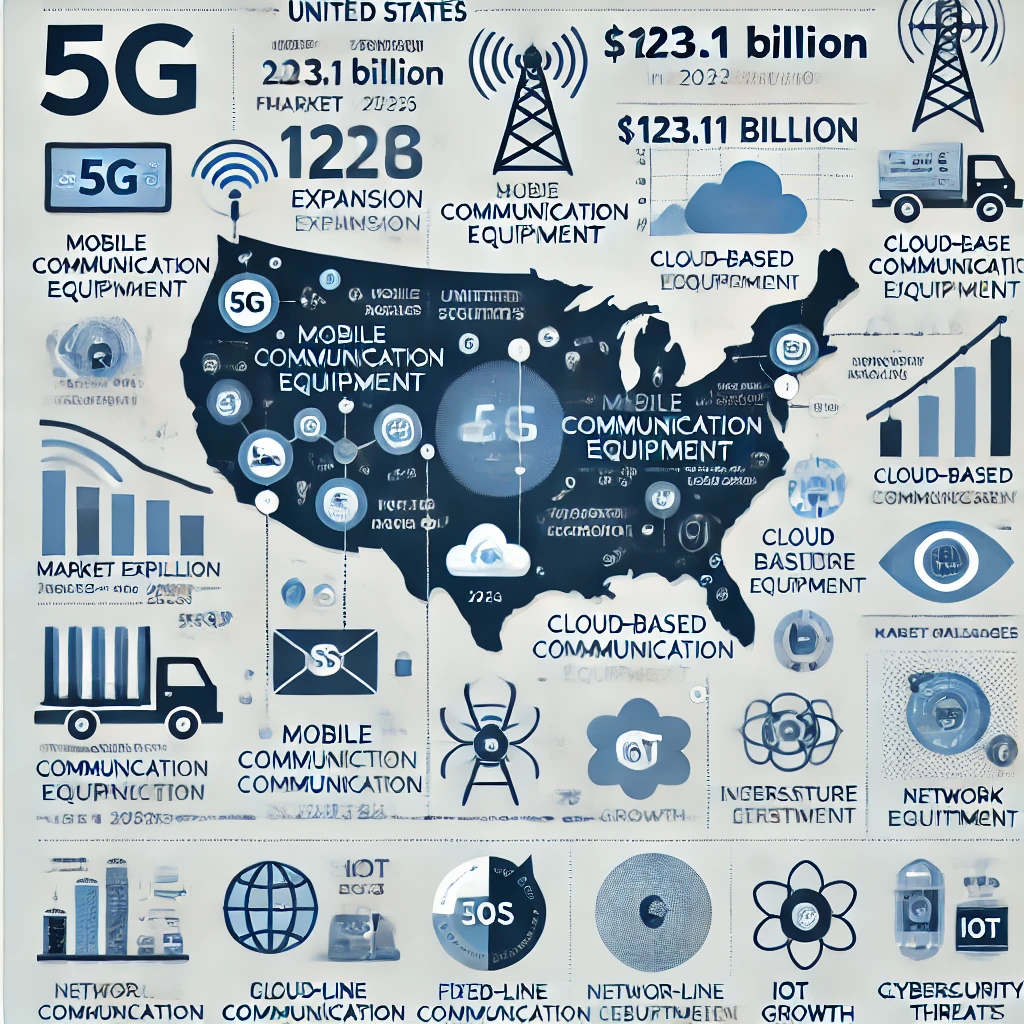United States Communication Equipment Market Analysis (2025-2033)
Market Overview
The United States communication equipment market is experiencing steady growth, valued at US$ 123.11 billion in 2024 and projected to expand at a CAGR of 3.42% to reach US$ 168.09 billion by 2033. The market’s expansion is driven by rapid advancements in 5G technology, Internet of Things (IoT), cloud computing, and high-speed communication infrastructure. Increased investments in wireless technology and connectivity solutions are also significant contributors to market growth.
Download Sample:https://www.renub.com/request-sample-page.php?gturl=united-states-communication-equipment-market-p.php
Key Market Segmentation
By Product
- Mobile Communication Equipment
- Fixed-line Communication Equipment
By Type
- Mobile Communication Devices
- Optical Communication Equipment
- Network Communication Equipment
By Region
- East United States
- West United States
- North United States
- South United States
United States Communication Equipment Market Dynamics
Market Drivers
1. 5G Network Expansion
The aggressive deployment of 5G networks is revolutionizing communication in the U.S. Telecom companies are making significant investments in fiber optics, small cell technology, and base stations to enable faster data transmission. 5G enhances applications such as autonomous vehicles, smart cities, IoT connectivity, and edge computing, further accelerating the demand for advanced communication infrastructure.
- Industry Collaboration: In February 2025, Aduna, AT&T, T-Mobile, Verizon, and Ericsson launched network APIs for SIM Swap and Number Verification, enhancing security and mobile ecosystem standardization.
2. Growth of Cloud-Based Communication Solutions
Businesses are rapidly adopting cloud-based VoIP, PBX systems, and unified communication platforms to enhance remote work efficiency and cost savings. The shift from traditional telephony to cloud-based communication has been accelerated by the rise of hybrid work models and digital transformation initiatives.
- Industry Update: In January 2025, Granicus released an update to its government-focused cloud-based communication solutions to meet evolving public sector needs.
3. Expansion of IoT and Smart Devices
The increasing adoption of IoT devices in smart homes, industrial automation, and healthcare is driving the need for high-speed, low-latency networks. The number of smart homes in the U.S. is expected to grow from 69.91 million in 2024 to 93.59 million by 2027.
4. Government Initiatives and Investments
Federal investments in broadband expansion, smart city projects, and secure communication networks are fostering market growth. Telecommunications companies are leveraging government funding to build next-generation infrastructure, ensuring seamless connectivity for urban and rural areas.
Market Challenges
1. High Infrastructure Costs
The cost of deploying 5G networks, fiber optics, and satellite communication systems is a significant barrier, particularly for small and medium-sized enterprises (SMEs). Network expansion requires substantial investments in data centers, security systems, and spectrum licensing fees.
2. Cybersecurity Threats and Data Privacy Concerns
As communication technologies evolve, the risk of cyberattacks, data breaches, and network intrusions continues to grow. Companies are investing in encryption, AI-based security solutions, and multi-factor authentication to combat cyber threats. Regulatory frameworks like GDPR and CCPA also impose strict data privacy requirements, increasing compliance costs.
Segment Analysis
1. Mobile Communication Equipment Market
The rising demand for smartphones, tablets, wireless routers, and mobile accessories is propelling growth in the mobile communication equipment sector. With 5G adoption accelerating, telecom providers are upgrading infrastructure to support faster, more reliable connectivity.
- Innovation Spotlight: In March 2025, Telness Tech launched MVNO services on T-Mobile’s 5G network, allowing mobile virtual network operators to expand their offerings in the U.S.
2. Fixed-Line Communication Equipment Market
Despite the dominance of mobile technology, fixed-line communication equipment remains essential in sectors such as government, finance, and healthcare. Fiber-optic networks and VoIP systems continue to be upgraded to ensure reliable, high-security communications.
3. Network Communication Equipment Market
The demand for routers, switches, fiber-optic components, modems, and Wi-Fi solutions is growing as businesses and consumers require higher-speed broadband and enterprise networking solutions. The rise of AI-powered network management, software-defined networking (SDN), and cybersecurity advancements is reshaping this market.
Regional Analysis
West United States Market
The western U.S., particularly California, Washington, and Nevada, is a technology powerhouse. Silicon Valley’s demand for high-speed networking, data centers, and cloud solutions drives innovation and investment in communication equipment.
East United States Market
Cities like New York, Boston, and Washington D.C. are major hubs for enterprise communication, financial networks, and government telecom solutions. Investments in VoIP, encrypted communications, and cloud-based infrastructure are prominent in this region.
North United States Market
Industries in Illinois, Michigan, and Minnesota are driving demand for industrial communication systems, IoT connectivity, and broadband expansion projects. The manufacturing and automotive sectors require robust automation and remote monitoring networks.
South United States Market
The South is experiencing rapid expansion in wireless and fiber-optic infrastructure, driven by growing urbanization and rural broadband initiatives. States like Texas and Florida are leading investments in smart city projects and IoT adoption.
Key Players & Competitive Landscape
Major players in the U.S. communication equipment market focus on product innovation, network infrastructure development, and cybersecurity enhancements.
Leading Companies:
- Apple Inc.
- LG Electronics
- Lenovo
- Xiaomi
- AT&T Intellectual Property
- Google Inc.
- Panasonic Corporation
- Sony Corporation
- OnePlus
These companies are investing in AI-powered communication tools, high-speed connectivity solutions, and next-generation networking hardware to maintain competitive advantages.
Market Opportunities & Future Outlook
- Adoption of AI and Edge Computing in Communication Networks
- Integration of Blockchain for Secure Telecommunications
- Advancements in Satellite-Based Internet Connectivity
- Rural and Underdeveloped Area Connectivity Expansion
- Emergence of Quantum Communication Technologies
Conclusion
The United States communication equipment market is poised for continued growth, supported by technological innovations, 5G advancements, cloud-based communication solutions, and increasing IoT adoption. Despite challenges such as cybersecurity risks and high infrastructure costs, the sector remains a critical driver of digital transformation and economic development in the U.S.













